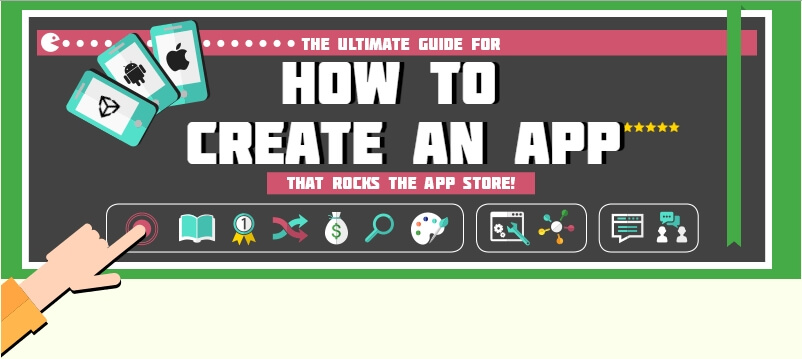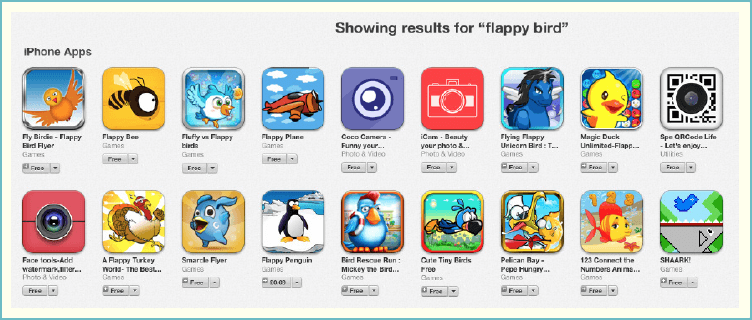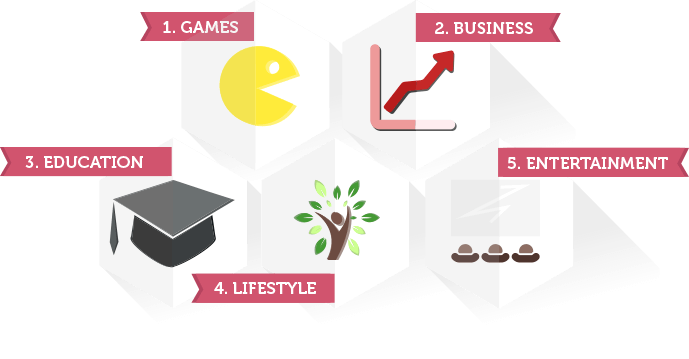

How to
Create an App


How to
Create an App
So, you have your idea and your gut is telling you this is going to work, I just know
it!
Or maybe you have a few ideas, none of them fully developed, but each of them with some potential.
Either way, your idea is likely to need refinement and development. When creating an app, you don’t
have
the luxury of working with a blank canvas. There are certain things you need to consider – such as
the
nature of the platforms you want to sell on, how your app will solve a problem, make lives better or
be
an addictive game, how much demand there will be for your app, how will you monetise it, what
technical
limitations could affect it etc..
Refining your idea doesn’t necessarily mean compromising on it. It just means turning it from a
pipedream
into something that’s actually going to work. To help you along the refinement process, which is vital after the ideation stage, we’ve listed a few crucial considerations for any aspiring app creator. But let’s start with a great example of a niche market app: Wag!

Wag! is an app for dog owners. The app allows you to find a dog walker just 30 minutes before you want to exercise your pet. Or, to create a more regular arrangement with a particular walker. The app keeps dog owners happy by providing them with a “report card” after each walk. This contains a photo of their dog, a map of the walk, and a “pee-poop” status update. Though currently only available in Los Angeles, San Francisco, and New York City, Wag! has a five stars rating on Apple’s App Store and recently raised $2.5 million in seed funding.
What is the intended outcome of developing your
app?
Are you aiming to make money?
Support an existing brand or service?
Help users educate or otherwise better themselves?
Or is it a charitable endeavour?
Whatever your reason for developing an app, you need to have a clearly
defined objective. If you don’t, you may create something that doesn’t achieve what you want. You must
define this and keep this front-of-mind throughout the development process. Ask yourself continually:
Will my app achieve
what I want it to achieve?
In his excellent post, “How to Validate your App Ideas”, David Janner, Editor of
MAKE
APP Magazine, suggests that those struggling to define their goals may benefit from speaking to business
owners, influencers,
bloggers, or any other relevant third-parties in order to find out what apps they’re likely to get
excited
about. This is a great way to start thinking about what your ambition is for your app.
Goals really do define success, as this 1979 Harvard Study shows: it asked students whether they had
goals
and whether they wrote them down. Only three per cent of students had written their goals down and those
that did were, on average, earning ten times as much ten years later than the other 97 percent of the
class
combined! »
You need to know exactly what your app will do. Apps are generally used for one or a handful of purposes. So it’s important that your app doesn’t try to do too much. A simple idea that is well executed must be your aim. Or as Marty sums this up perfectly:
When deciding your app’s purpose, it’s important that you understand how it will make its users’ lives better. Whether that is by improving productivity or memory, relieving boredom, adding competition or a challenge, helping health, fitness and wellness, or solving financial budgeting, if your idea doesn’t significantly improve its users’ lives, it’s unlikely to be successful. For example, ad blocker app Peace shot straight to the top of
the iTunes Paid App charts just hours after its release on September 17, 2015. »
This is because Peace promised to do something that people were very excited about: block adverts on
their
mobile devices. People realised that Peace could positively affect their lives in a very real way, and
the
developers reaped the rewards.
Does an app similar to your idea already exist?
To find out, search all of the biggest apps stores with any relevant terms. And don’t make your terms
too
narrow. For example, imagine you’re creating a bowling game. You search terms such as “bowling”, “ten
pin”,
“strike”, etc., and are delighted to see that nothing comes up. But, unbeknownst to you, there exists an
incredibly popular skittles game that doesn’t mention the words “bowling”, “ten pin”, and “strike” at
all.
If a similar app does exist, this doesn’t necessarily mean you have to throw in the towel. Perhaps the
rival
app is poor quality with lots of bugs. Perhaps it’s badly marketed. Perhaps it only does some of what
you
want yours to do. Perhaps it is offering too many features
so that they are all watered-down, or weaker in some areas than others. If any of these things are true,
then you need to ensure you don’t make the same mistakes as your competitor.
Download the app, have a good look at it,
and see what you can do to improve it.
However, if your idea is very similar to an existing and popular app, you may have to go back to the
drawing
board unless you have some significant improvements up your sleeve. If this is the case, think about
ways to
differentiate your app and make it better than the competition.
At the peak of the Flappy Bird craze, over 60 Flappy Bird clones hit the Apple App Store every day. Most of these were too similar to the original to attain any real level of success. However, modifying and bettering a good idea isn’t the same as cloning. If you have direct competitors, you need to make sure your app goes the extra mile.
Fly Birdie was almost identical to Flappy Bird, and made no attempt to improve on the original. As such, it received a frosty reception and plenty of negative reviews. 2048, however, was very similar to Threes, in which players slide blocks to complete a number puzzle. But 2048 had better playability, music, and design, earning it over four million visitors in a week. »

Your idea may be fantastic. But if there’s no realistic way to realise it, then you need to figure that out as soon as possible. Dhru, again, accurately defines what this means with some great advice too – think about this a little:
If you’re a developer, you should have a good idea about what’s possible or what isn’t. If
you’re less technically-minded, you need to sit down with someone whose expertise will tell you the
opportunities and challenges the idea may come up against.
As developer Milan van den
Bovenkamp, founder of Making Technology Come Alive!, puts it:
And bear in mind, even though something may be possible, do you have the budget and resources to make it happen? After all, you have only a very small window of opportunity to make a great initial impression: according to research conducted by Eran Yaniv’s company, perfectomobile.com, customers will try something else after just two bad experiences with an app.
Most app stores divide the apps into categories.
The Apple App Store’s categories include:

Look at the store(s) you intend to distribute your app on and see what category best suits your app. Some categories have more free apps than paid ones, and vice versa. See how the land lies in your category. This will help you determine whether your app is more likely to be popular if free, freemium or paid. In chapter nine we
go into more detail about monetisation models – so feel free to jump ahead if that’s of interest, but be sure to come back and pick up where you left off so you don’t miss anything that could mean the difference between success and failure! Just remember to check the most popular categories as part of your research.
For example, the most popular five Apple App Store categories
in September 2015 were:

There are various models for monetising apps. One will likely be best suited to your app idea. Therefore do your research because it’s important that you pick the right one – this one decision can be the difference between success and failure.
Some popular monetisation models include:
And remember,
none
of these models are mutually
exclusive. You’re free to combine two or more in order to
find the model that best suits you.
When deciding on the details of your app, you should strongly consider developing an app for a
niche
market.
A niche market is a subset of the market on which a specific product is focused. These could
include
less popular sports and hobbies markets, language-specific markets, geographically-specific
markets,
lifestyle-specific markets, etc..
By their very nature, apps specifically designed for niche markets
are
less likely to have been created, meaning that the market is often unsaturated or even empty.
However,
there is often a high enough level of demand to support a particular product, and, since it won’t be
available elsewhere, those who provide it can often charge a premium.
Choosing to target a niche market immediately differentiates your app from the rest, it reduces the
amount of competition you face, and gives you a clearly defined target market.
In the next chapter, we look in detail at how to conduct niche market research. If you’ve already decided not to target a niche market you can skip this chapter. However, some of the research advice may still be applicable to you.
Windfinder is an app for anyone with an interest in the wind, waves, weather, and tides – kitesurfers, windsurfers, sailors, paragliders, and more. It provides forecasts from over 40,000 spots, collects observations from over 18,000 weather stations, and allows for configurable favourites and measuring units. The app has a 4.5 star rating from over 11,000 users and has been installed on over 1,000,000 devices. Windfinder shows how targeting the right niche market with a unique idea can be an excellent decision.

Staying true to your vision is important. Being flexible on how you actually realise your vision is vital. Therefore it is critical that you spend time at the beginning clearly outlining your objective, and then keep this as your central focus. Don’t shirk the all-important research, and certainly do not be afraid to ask questions of others – whether friends and family, or analysts and
app developers – and do some research to ensure that your idea has
merit, or to ensure that you tweak your concept before it is too late. And constantly question
yourself
– be honest about what you want your app to do and what is possible.
Then figure out how
you want to monetise it.